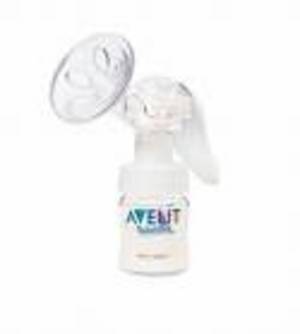Many mothers’ end up going back to work or school after the birth of their child and it may seem like continuing to breastfeed could be difficult, but it doesn’t have to be. There are significant advantages to continuing to feed your baby human milk including a stronger immune system and less illness, meaning you miss less work and so your employer benefits as well. Most work places allow for pumping and times to do so, it would be wise to address this before maternity leave or returning to work so that you know how to plan out your pumping sessions.
Nowadays there are wonderful breast pumps available that allow for quick, easy, discreet and efficient pumping. There are two types of breast pumps on the market, manual and electric. For occasional pumping, like part-time work or school or an evening out every once in a while a manual pump will likely be sufficient. If you need to pump multiple times a day and get larger amounts in less time, then an electric pump is the way to go. There is a pretty big price difference between the two types but both are significantly less than the cost of formula and your baby will benefit from your purchase and time devoted to expressing breast milk.
A good quality manual breast-pump costs about $60 like the popular Avent Isis Back-to-work kit. It seems to be a favorite for moms who need to pump and may even work well enough for full time employment, depending on how often you need to pump and how efficient it empties your breasts when used. Other good choices for manuals are Dr. Brown’s Natural Flow Breast Pump – $50 and the Medela Harmony breast pump which sells for $35. All three of these manual pumps get good reviews and come highly recommended. The downfall is that you have to use your hand to pump and squeeze the trigger to express any milk, which can be tiring and take longer, but the price is right if this is an option for you. Manual pumps are also single pumps meaning you can only express from one breast at a time, whereas many electric pumps allow for dual pumping which means more milk in less time.
Some top selling electric pumps are the Medela Pump-in-Style which costs about $250-$320 depending on the accessories added. Pricey but very efficient and has a quiet motor that will last thru many babies and allow for thousands of ounces of healthy breast milk to be expressed. Another good dual electric is the Ameda Purely Yours breast pump. Cost is around the same at $250 and offers many of the same features. Both of these pumps fit standard sized baby bottles but there are also adaptors that can be purchased to allow pumping in wide neck bottles as well. A newer double electric that gets rave reviews is the Playtex Embrace breast pump which also costs $250 and like the previous two comes with a stylish carrying case for easy transport. Electric pumps require a power source, an AC adapter is included as well as a battery pack. Car adapters are also available so that pumping on the go is still possible. A good place to read consumer reviews on breast pumps and other products is epinions.com. Your local Babies R Us sells a variety of breast pumps, both manual and electric.
It is important to pump every 3-4 hrs or so when at work so that you maintain a good milk supply and so that you have enough breast milk to send with your baby each day. Find a comfortable place to sit, preferably in private as it’s hard to relax if you are worried about being interrupted. Have everything set up and ready before you begin pumping and of course wash your hands first. It may be helpful to have a glass of water available and a picture of your baby in view to help with your let-down reflex. Don’t get frustrated if you are only able to pump a small amount the first few times, even the best pumps are much less effective than a baby sucking but your body will adjust and in time you will likely get much more at each pumping session. Remember each ounce you express will go into your precious, growing baby. It should not be painful to pump, so adjust the pressure if it is uncomfortable.
Expressed breast milk can be stored in an ice pack cooler until you get home or even better a refrigerator or freezer. Refrigerated milk generally lasts for 7 days and frozen milk for up to 6 months. Your child’s caregiver can easily warm or defrost breast milk by placing the bottle in a cup of hot water until the desired temperature is achieved. Electric bottle warmers also work well and may speed up this process. Breast milk should never be heated in a microwave as precious nutrients are destroyed as well as the chance of un-even temperature possibly burning your baby’s mouth.
If you miss a pumping session you will likely become engorged and need to at least express a small amount to relieve any discomfort. Remember that breastfeeding and pumping is a supply demand situation so the more you pump the more your body makes, the longer you go between breastfeeding and pumping the less milk you will produce. This is why it’s important to pump regularly while away from your baby, as often as you would nurse if at home if at all possible. Many women still successfully breastfeed in the evenings and weekends even when they are unable to pump at work but it takes more commitment and a good supply once your body adjusts to not needing milk during certain hrs each day. The more you supplement with formula, the less breast milk your body will be make so doing so can become a vicious cycle. While time consuming and possibly annoying, pumping for your baby and continuing to breastfeed is one of the most important things you can do health wise for your child. And they grow up so quickly, so it’s helpful to remember that you won’t be attached to the pump forever. But your little one will benefit for a lifetime.


